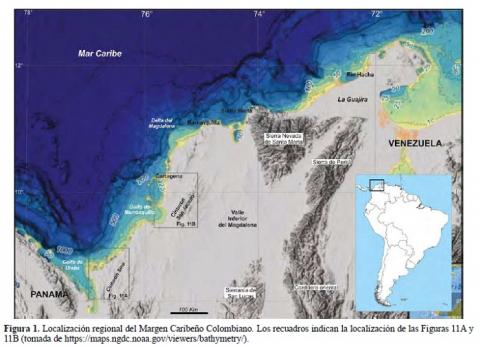Rossello, E.A.; Osorio, J.A.; López-Isaza, S.
2 022
Boletín de Geología vol. 44, n.° 1, enero-abril de 2022
Se analizan la morfología y evolución de los diapiros y volcanes de lodo en el Margen Caribeño Colombiano (MCC), emplazados en secuencias sedimentarias transgresivas del Cretácico al Neógeno. Son estructuras extrusivas por argilocinesis que muestran la liberación de sedimentos sobrepresionados y fluidizados por aguas y/o hidrocarburos que intruyen hasta la superficie. A partir de la modelación analógica, se concluye que los condicionantes del origen y geometría de los mecanismos del diapirismo dependen de: i) la menor densidad de los niveles generadores infrayacentes en comparación con las secuencias suprayacentes y ii) de las débiles tasas de sedimentación de las secuencias que los post-datan. La exhumación progresiva del Cinturón Sinú-San Jacinto a partir del Oligo-Mioceno, debido a la convergencia tectónica transpresiva dextral entre las placas Sudamérica y Caribe, generó una barrera al transporte sedimentario hacia el norte del paleo río Cauca. Esta interrupción impidió su descarga directa, forzándolo a coalescer hacia el río Magdalena. Se propone un provincialismo del diapirismo a partir de las diferencias en las tasas de progradación de sedimentos más densos sobre secuencias pelíticas asociadas con conspicuos tipos de plegamientos intensos: a) al norte (Cinturón San Jacinto), compresional tangencial con ejes de pliegues doblemente buzantes y escalonados subparalelamente al litoral Caribe y b) al sur (Cinturón Sinú), gravitatorio con amplios sinclinales en forma de cubetas y anticlinales estrechos. El mejor conocimiento de la evolución 4D del diapirismo en el MCC contribuye en la definición del potencial de los sistemas petroleros infrayacentes y en la prevención de riesgos ambientales en las maniobras exploratorias.
The morphology and evolution of diapirs and mud volcanoes in the Colombian Caribbean Margin (MCC) located in transgressive Cretaceous to Neogene sedimentary sequences are analyzed in this paper. They are extrusive structures by argilokinesis that show the release of overpressure and fluidized sediments by water and/or hydrocarbons that pierce the surface. From the analogical modeling of the determining factors of origin and geometry, the diapirism mechanisms depend on: i) the lower density of the underlying generating levels compared to the overlying sequences, and ii) the weak sedimentation rates of the overlayered sequences. The progressive exhumation of the Sinú-San Jacinto Belt from the Oligo-Miocene period due to the dextral transpressive tectonic convergence between the South American and Caribbean plates, generated a barrier to sedimentary transport to the North of the Paleo Cauca River. This interruption prevented its direct discharge, forcing it to coalesce into the Magdalena River, increasing the volume of its delta. A provincialism of diapirism is proposed based on the differences in rates and chronologies of the progradation of denser sediments on pelitic sequences associated with conspicuous types of folds: a) to the north (San Jacinto Belt), tangential compressional type with a double plunge, and oriented subparallel to the Caribbean coast, and b) to the south (Sinú Belt), gravitational type with wide synclines and tight anticlines. Better knowledge of the 4D evolution of MCC diapirism contributes the potential of the underlying oil systems and the prevention
of environmental risks in exploratory maneuvers.
of environmental risks in exploratory maneuvers.

